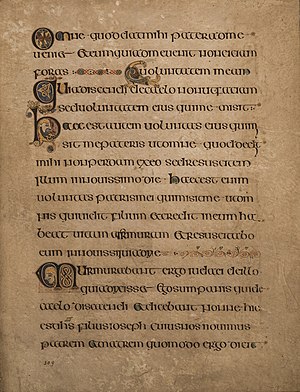
Back أنسيال Arabic Caligrafía uncial AST Унцыял Byelorussian Uncial Catalan Unciála Czech Uncial (skrift) Danish Unziale German Στρογγυλόσχημη γραφή Greek Uncialo Esperanto Caligrafía uncial Spanish
This article needs additional citations for verification. (April 2013) |

In a Western context, Uncial is a majuscule[1] script (written entirely in capital letters) commonly used from the 4th to 8th centuries AD by Latin and Greek scribes.[2] Uncial letters were used to write Greek and Latin, as well as Gothic, and are the current style for Coptic and Nobiin.
In a Slavic context, Uncial/Ustav and Semi-Uncial/Poluustav scripts were used from the 9th to the 17th century AD to write the Slavic languages in Cyrillic. It can still be used today in academic or religious publications.
Slavic professors use also the english terms[3] even if the comparison to the Western European style is considered inadequate by some palaeographers.[4] Indeed the Greek ustav, a separate category in Slavic terminology[5] is often combined with uncial writing because in some European languages, the "ustav" and the uncial (as well as the semi-ustav and semi-uncial) are generally called the same word.
- ^ Glaister, Geoffrey Ashall. (1996) Encyclopedia of the Book. 2nd edn. New Castle, DE, and London: Oak Knoll Press & The British Library, p. 494. ISBN 1884718140
- ^ The Cambridge Encyclopedia of The English Language. Ed. David Crystal. Cambridge: Cambridge University Press, 1995. p. 258.
- ^ SHORT HISTORY OF THE CYRILLIC ALPHABET by IVAN G. ILIEV., ISSN 2158-7051, INTERNATIONAL JOURNAL OF RUSSIAN STUDIES, ISSUE NO. 2 (2013/2)
- ^ English wiktionary, Usage notes for the word ustav: "Ustav and poluustav writing is often referred to as Cyrillic uncial and semi-uncial script, but the comparison to the Western European style is considered inadequate by some palaeographers, so the Slavic words are also used in English-language writing."
- ^ "... In the Byzantine period, from the IV—V centuries AD, this [uncial] handwriting passed into the "ustav", which was used most often for church books..." (Istrin 1965, p. 350). «…В византийский период, с IV—V вв. н. э., почерк этот [унциал] перешел в „устав“, применявшийся чаще всего для церковных книг…» (Истрин 1965, стр. 350).
© MMXXIII Rich X Search. We shall prevail. All rights reserved. Rich X Search